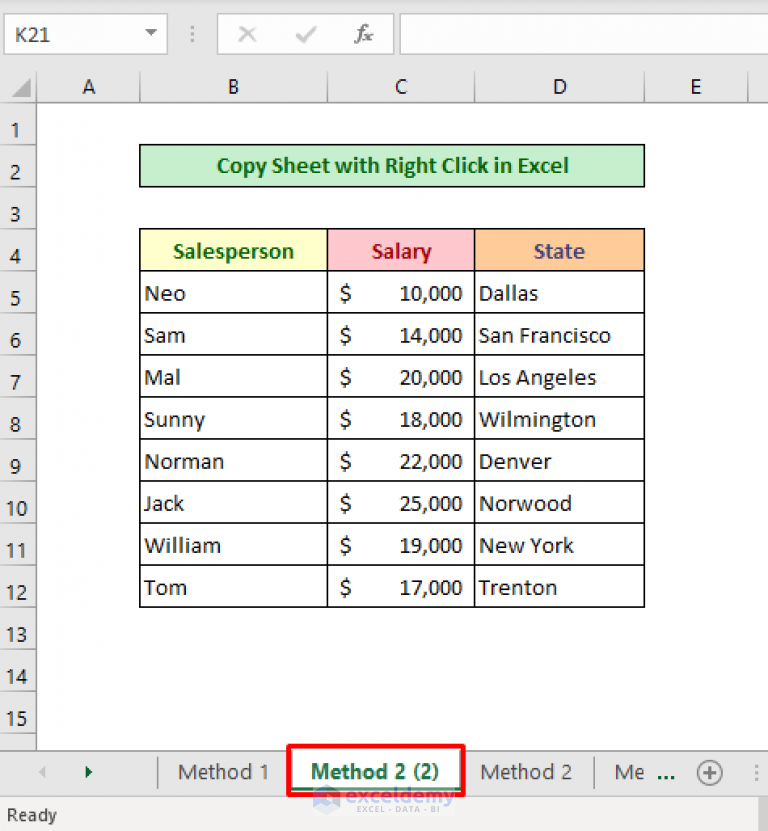5 Ways to Copy an Excel Sheet Easily

The need to copy Excel sheets is a common task that arises in various data management scenarios. Whether you're an accountant, a data analyst, or simply organizing your personal budget, knowing how to replicate sheets quickly and efficiently can save a significant amount of time. Here, we outline five methods to help you copy an Excel sheet without breaking a sweat:
Method 1: Using Excel’s Built-in Commands

Excel provides a direct approach to copying sheets:
- Right-click the tab of the sheet you want to copy.
- Select “Move or Copy” from the context menu.
- In the dialog box, check “Create a copy” and choose where to place the new sheet. Click “OK.”
Embed a screenshot here
Method 2: Drag and Drop Technique

This method is ideal for quick, on-the-spot copying:
- Press and hold the Ctrl key.
- Drag the sheet’s tab to the desired location within the workbook or to another open workbook.
💡 Note: Ensure you have the workbook you want to copy to already open to avoid any confusion or unwanted file creations.
Method 3: Using Keyboard Shortcuts

Keyboard shortcuts can significantly streamline your workflow:
- With the sheet active, press Alt + E, then press M to open the “Move or Copy” dialog.
- Choose your settings as in Method 1 and hit Enter.
Embed a keyboard image here
Method 4: VBA Macro for Repetitive Tasks

If you find yourself copying sheets frequently, consider using a VBA macro:
Sub CopySheet()
Dim sourceSheet As Worksheet
Set sourceSheet = ThisWorkbook.Sheets(“Sheet1”)
sourceSheet.Copy After:=Workbooks(“DestinationWorkbook.xlsx”).Sheets(“Sheet2”)
End Sub
This code copies "Sheet1" from the active workbook to after "Sheet2" in "DestinationWorkbook.xlsx."
📝 Note: Always test your macros in a safe environment to avoid data loss or corruption.
Method 5: Export to CSV and Import

This method is useful if you need to copy data outside of Excel:
- Save the sheet you wish to copy as a CSV file.
- Open the new workbook or worksheet where you want the data to be copied.
- Use the “Get External Data” feature in Excel to import the CSV file into your new location.
Considerations When Copying Sheets

Before diving into the copying process, consider these important points:
- Format Integrity: Formatting might not be preserved when copying between different Excel versions or when using different methods.
- Data Validation Rules: Ensure these are copied if needed for your data.
- Formulas and References: Be aware that relative and absolute cell references might change when sheets are moved or copied.
🔔 Note: Always verify that all necessary elements like macros, charts, and comments are intact after copying.
Summing up, copying Excel sheets can be accomplished in various ways, each suited for different user needs. Whether you prefer the traditional click-through approach, a swift drag and drop, or the power of automation through VBA, Excel offers multiple avenues to achieve this task efficiently. By mastering these methods, you'll enhance your productivity and streamline your data management processes. Remember that each method comes with its nuances, so choose the one that best fits your workflow and data integrity requirements.
What happens to data validation when copying sheets?

+
Data validation rules are usually copied along with the sheet, but they might need adjustment if references change or if the destination workbook uses different Excel settings.
Can I copy sheets between different Excel files?

+
Absolutely! Most methods allow you to copy sheets within the same workbook or to another open workbook. The VBA method, for instance, can even automate this process across different workbooks.
Are there any limitations to copying sheets?

+
The main limitations include potential formatting issues, loss of certain VBA functionalities, and the need to adjust formulas or references after the copy operation, especially if relative references are used.